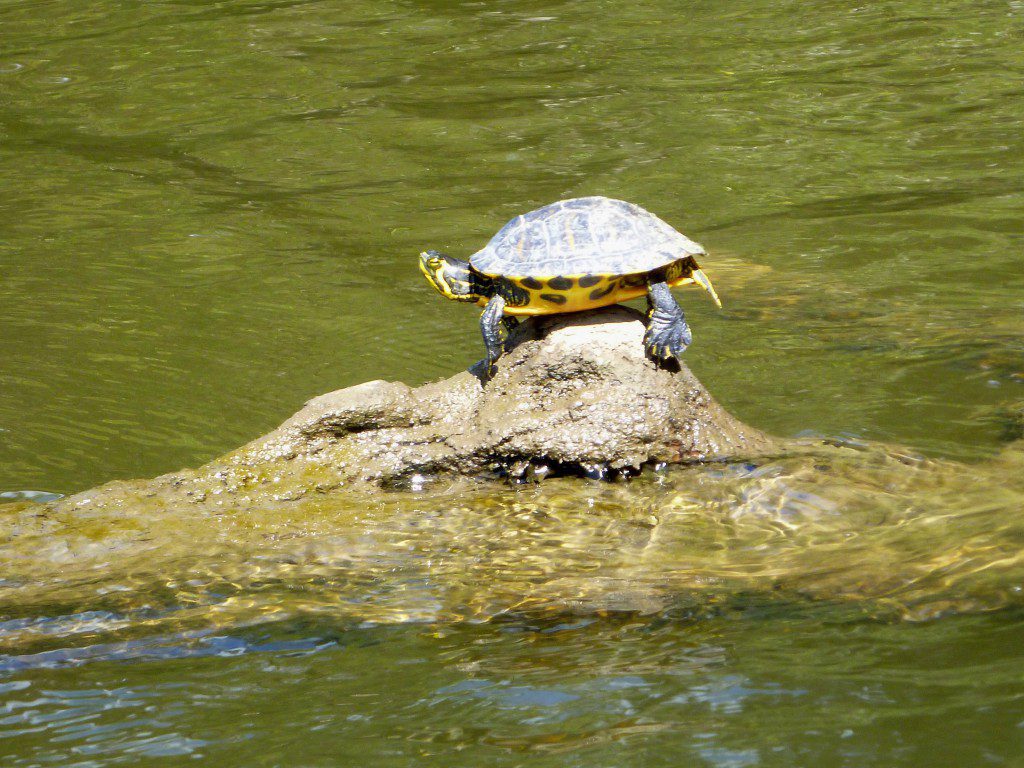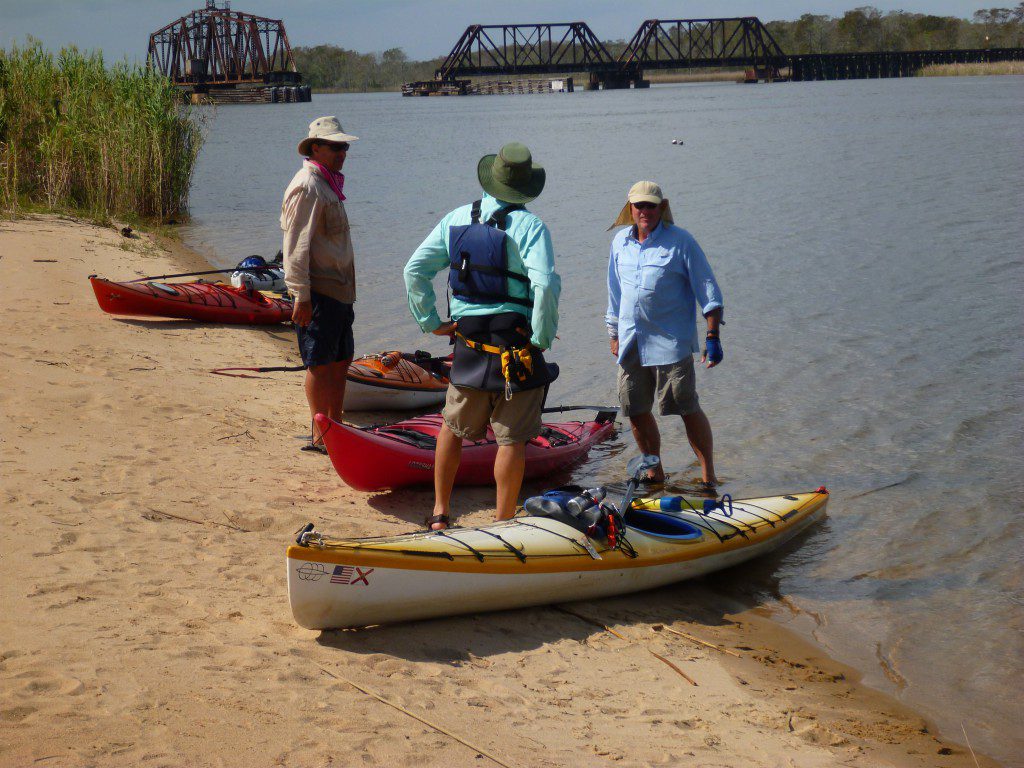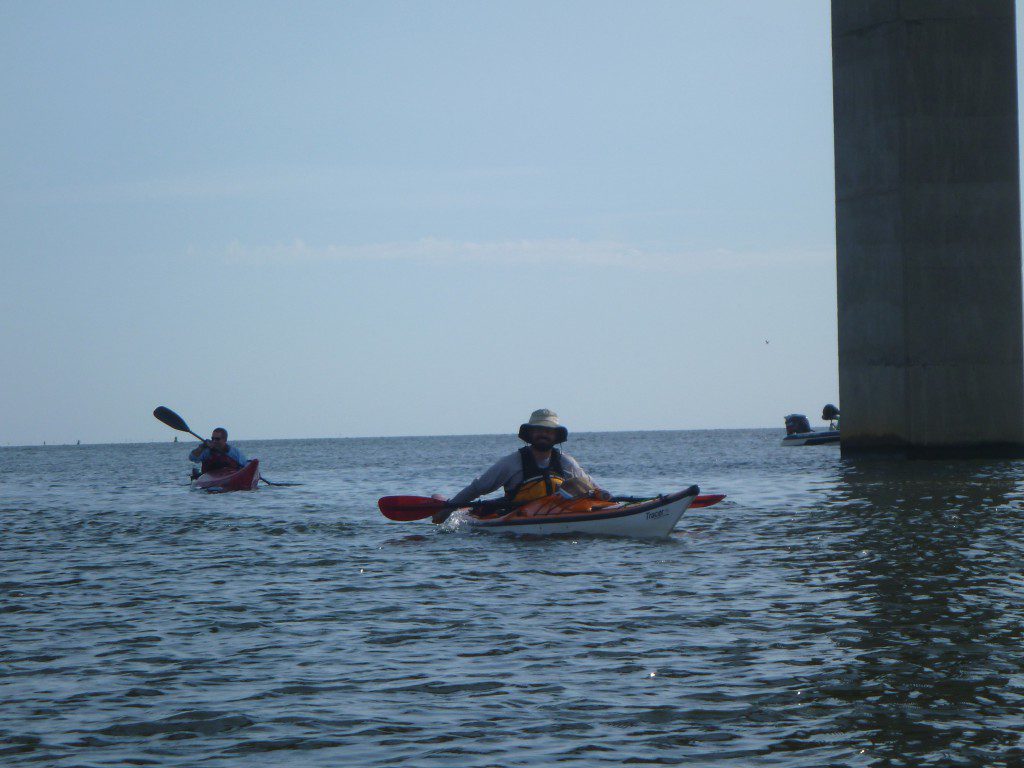Rob Diaz de Villegas WFSU-TV
Every morning starts with interesting noises that hear from my sleeping bag. I’ve been spending a lot of time listening, and I always hear other people up coughing, walking around. Camping doesn’t always mean great sleep. This morning, what I heard most was a constant ocean-like noise. I know we were by mile marker 22, still pretty far from the Gulf. I wondered if I could hear the tide, as tidal influence was to be felt not too much further up the river. I asked about that, and was told that perhaps I was hearing the river current.
A few miles into our paddle, we stopped by Fort Gadsden and Doug talked about the historical significance of the place. Built during the War of 1812 by the British, they abandoned it at the conclusion of the war to a group of free blacks, escaped slaves, and various native groups. Negro Fort, as it was then called, was a haven for escaped slaves until US troops fired a cannon ball heated in a stove into the fort’s gunpowder stores. The explosion killed hundreds. Doug had provided us the chapter about Fort Gadsden from his upcoming book on the Seminole Wars. We stopped again at the site of another battle, at Bloody Bluff.
We were to stay closer together today, and keep someone with a map nearby (Doug, Rick, and Chris). Rivers and creeks join and split off from the river in the lower twenty miles, and it would be a lot easier to get lost. The plan was to take one last break at a small beach after the railroad bridge, at mile marker 3 more or less. We would stick close together and paddle in line into the city for the people waiting for us.
The day’s paddling seemed a little slower, as we had an incoming tide and some head wind. We also passed larger boats (including a shrimp boat) that kicked a lot of wake our way. Sometimes it felt like I was paddling in oatmeal. When it came time to get into formation, my lens started fogging up and I had to change cameras and switch my last good battery into the camera I had stashed behind my seat. Georgia is yelling “come on Rob!” but I know I can’t not have this shot. And it’s either video or stills, so I took video.
We were to come out of the main river and turn into the channel that runs alongside the oyster restaurants and Veteran’s Park, where people were waiting for us. As we turned the corner to head to the park, I could see an adult form holding hands with a toddler- it was my wife Amy and my son Max. I told Georgia I saw them and she told everyone, “On the count of three, everyone yell ‘Hi Max!'” As much a I’ve enjoyed this trip, I couldn’t have been any happier to see them.
We got to the park, waved to our friends, family, and well wishers, and all that was left was the race. And these guys don’t play fairly. There was supposed to be a race for anyone who wanted to go touch the Gorrie Bridge. As Georgia was trying to get them organized to start, Rick, Micheal, Josh, and Bryan just took off. I wanted to tape this, but by the time I got my camera recording and turned around to get after them, they were pretty far ahead. It got pretty close, with Rick closer to a beam on the left and Bryan closer to one on the right. Competitive in both paddling and finding venomous snakes, Bryan Desloge took this one.
We all gathered at Up the Creek Raw Bar and ate together with each other and our loved ones. We will all be sleeping in beds tonight. We started in the thickest fog and emerged into tall bluffs and wide sandbars, climbing one of the tallest and sleeping on a couple of the sandbars (Estiffanulga sand is still on a lot of my stuff). The bluffs got lower again and creeks and cypress swamps offered interesting side adventures. Men fished and hunted, fishhooks hung from trees, houseboats and floating kennels lined the shores. Herons evaded us, eagles circled overhead, and fish never stopped jumping (I wish I would have been rolling when that pinfish bounced off my bow). Woods give way to marshes and the bay just opened up in front of us. It’s been ten years since I first visited Apalachicola, for WFSU’s Our Town program. I never thought I would enter it this way. As we drove home over the bridge, in the last light of the day, I thought to myself “I can’t believe I just paddled that river.”
For more information on Rivertrek, visit the official page. This page is on the Riverkeeper web site, and you can further explore what they do for the river. (They’re also on Facebook).
The Franklin County Promise Coalition is coordinating aide efforts for families that are being affected in Franklin County through their Bay Aid program. As Dan told us in his original interview, over half of the residents of Franklin County depend on the river for their livelihoods. Learn more about volunteering and other Bay Aid opportunities here.



